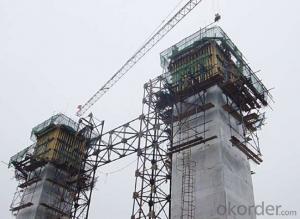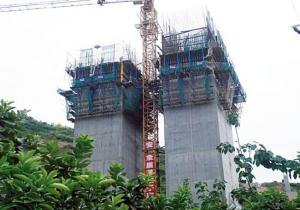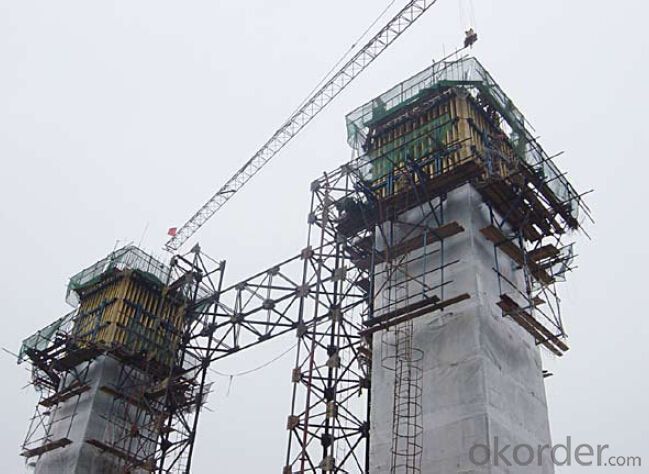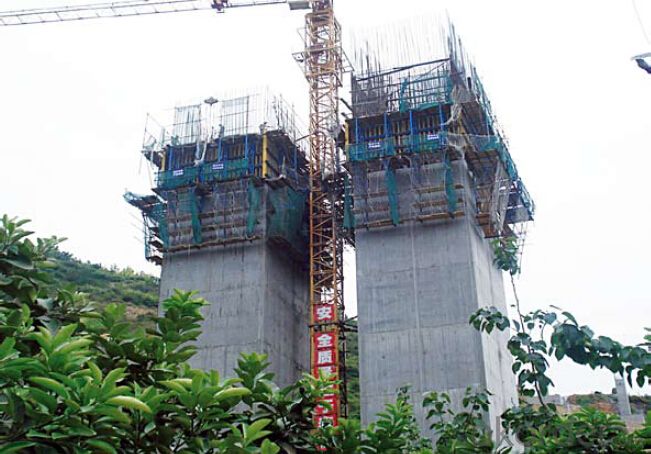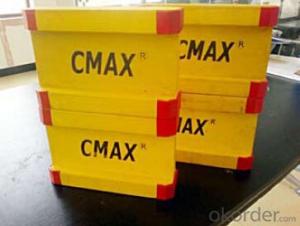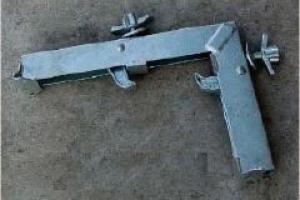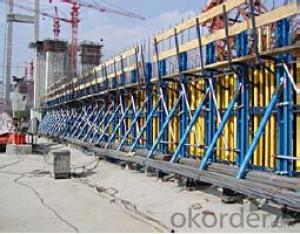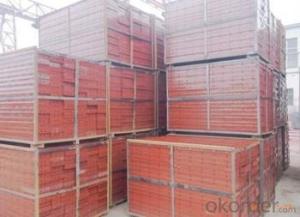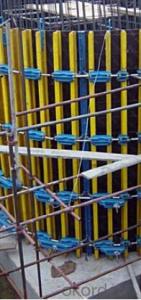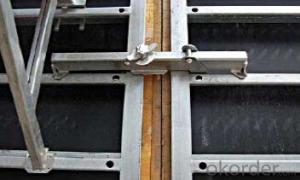Climbing Bracket for Formwork and Scaffolding Systems
- Loading Port:
- Tianjin
- Payment Terms:
- TT OR LC
- Min Order Qty:
- 50 m²
- Supply Capability:
- 1000 m²/month
OKorder Service Pledge
OKorder Financial Service
You Might Also Like
Climbing Bracket CB240 & CB210
They are framework brackets for supporting large-area wall formwork.
Typical applications for the CB240&CB210 are pier and column/shear wall/core walll/ in the
building.
CB210 has smaller size than CB240, it will be cost effective in some condition.
Characteristics:
◆ High bearing capacity
The high loading capacity of the brackets allow very large scaffold units. This saves the number
anchor points required as well as reducing climbing times.
◆ Simple moving procedure by crane
Through the strong connection of formwork together with the climbing scaffold, both can be moved
as a single climbing unit by crane. Thus valuable time-savings can be achieved.
◆ Fast striking process without a crane
With the retrusive set, large formwork elements can also be retracted quickly and a minimum of
effort.
◆ Safe with work platform
The platforms have assembled firmly with bracket and will be climbing together, without scaffolding
but can work safely in spite of your high location.

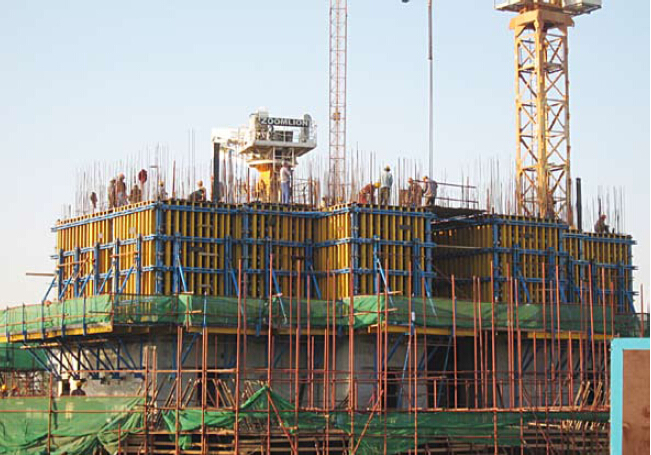
- Q: What are the common challenges faced during steel formwork installation?
- Some common challenges faced during steel formwork installation include ensuring proper alignment and leveling of the formwork, handling heavy and bulky steel components, securing the formwork against displacement during concrete pouring, and maintaining structural stability and integrity throughout the installation process. Additionally, coordinating with other construction activities, such as rebar placement and concrete pouring, can also be a challenge to ensure smooth and timely progress of the formwork installation.
- Q: How does steel formwork affect the speed of construction?
- The numerous advantages of steel formwork greatly enhance the speed of construction. Firstly, its high durability allows for multiple pours without the need for replacement or repair, eliminating downtime associated with timber formwork. In addition, steel formwork is easily assembled and disassembled due to its modular nature, reducing overall construction time. This is particularly beneficial for time-sensitive large-scale projects. Furthermore, steel formwork ensures precise and uniform construction, eliminating excessive rework and adjustments. This saves both time and resources. Moreover, steel formwork can handle high concrete pressures, allowing for faster pouring and setting of concrete. This eliminates the need to wait for the formwork to fully cure before proceeding to the next pour, resulting in faster construction cycles and increased productivity. Lastly, steel formwork is compatible with various construction techniques and can be easily adapted to suit different project requirements. It can be used for a wide range of applications, enabling faster construction of diverse building elements. Overall, steel formwork significantly speeds up the construction process by offering durability, ease of use, dimensional accuracy, and compatibility with different construction techniques. Its ability to handle high concrete pressures and its modular nature contribute to faster construction cycles and increased productivity, making it an ideal choice for efficient construction projects.
- Q: What are some of the components of the combined steel template, what role?
- First, the material requirements1, the length of the plane template specification: 450, 600, 750, 900, 1200, 1500; width:: 100, 150, 200, 250, 300mm, rib height are 55mm, code2, setting steel angle mould internal corner template specification: width 150mm * 150mm, 100mm * 150mm; length of 450, 600, 900, 1200, 1500mm; rib height of 55mm, named E; Yang angle template specification: width 100mm * 100mm, 50mm * 50mm. The length and the rib height with the internal corner template, code named Y; connecting angle template specification: width 50mm * 50mm, and the length of rib height template likewise yam Kok, named J.
- Q: Can steel formwork be used for both horizontal and vertical concrete placement?
- Yes, steel formwork can be used for both horizontal and vertical concrete placement. Steel formwork is a versatile and durable solution for creating molds or frames that hold wet concrete in the desired shape until it sets and hardens. This type of formwork is commonly used in construction projects for various applications, including both horizontal and vertical concrete placement. Steel forms are strong enough to withstand the weight and pressure of the concrete, making them suitable for vertical applications such as walls, columns, and beams. Additionally, steel formwork can be easily adjusted or modified to accommodate different shapes and sizes, making it ideal for horizontal placements like slabs, floors, and pavement. Overall, steel formwork offers flexibility, strength, and stability, making it suitable for a wide range of concrete placement requirements.
- Q: How does steel formwork perform in seismic-prone areas?
- Due to its inherent strength and durability, steel formwork performs exceptionally well in seismic-prone areas. Unlike timber or plywood formwork, steel formwork offers superior resistance to seismic forces, providing a rigid and stable structure capable of withstanding lateral forces generated during an earthquake. One of the main advantages of using steel formwork in seismic-prone areas is its ability to maintain structural integrity and stability. The high tensile strength of steel enables it to resist the powerful shaking and ground motions associated with seismic activity. As a result, steel formwork is less likely to deform, crack, or collapse during an earthquake, ensuring the safety of both the structure and the construction workers. Additionally, steel formwork possesses excellent load-bearing capacity, which is crucial in seismic-prone areas. The formwork system provides robust support to the concrete during casting and curing, ensuring the structure remains intact even under dynamic loading conditions. This ability to withstand heavy loads is particularly important in earthquake-resistant design, as it helps prevent structural failure and the resulting loss of life and property. In addition to its strength, steel formwork offers other advantages in seismic-prone regions. It is highly reusable, durable, and resistant to moisture, making it ideal for construction projects in areas with high seismic activity. The reusability of steel formwork reduces construction waste and allows for long-term cost savings. Furthermore, steel formwork is versatile and adaptable, making it suitable for various structural applications in seismic-prone areas. It can be easily customized to fit different shapes and sizes, facilitating the efficient construction of complex structures. This flexibility is crucial in earthquake-resistant design, where the formwork must conform to specific architectural and structural requirements. Overall, steel formwork is an excellent choice for construction in seismic-prone areas. Its strength, durability, load-bearing capacity, reusability, and adaptability make it a reliable and efficient solution for withstanding the forces exerted by earthquakes. By utilizing steel formwork, construction projects can enhance the safety and resilience of structures in regions prone to seismic activity.
- Q: What are the different types of safety precautions required when working with steel formwork?
- When working with steel formwork, some of the different types of safety precautions that are required include wearing appropriate personal protective equipment (PPE) such as hard hats, safety glasses, and steel-toed boots to protect against falling objects and accidental injuries. It is also important to ensure that the formwork is properly secured and stable to prevent collapse or accidents. Workers should be trained on safe lifting and carrying techniques to avoid strains and sprains. Additionally, regular inspections of the formwork should be conducted to identify any potential hazards or defects that need to be addressed.
- Q: Can steel formwork be used for tunnel linings?
- No, steel formwork is typically not used for tunnel linings. Instead, materials like concrete or shotcrete are commonly used for tunnel linings due to their strength and durability.
- Q: I would like to ask you 60 models of building steel formwork, steel mold fixed method and fixed plate type fixed hole number
- P6015:600 * 1500mm, P6012:600 * 1200mm, P6009:600 * 900mm, construction templates generally use U card or bolt fixation
- Q: How does steel formwork affect the schedule of a construction project?
- The schedule of a construction project can be greatly impacted by steel formwork. The durability and reusability of steel formwork are one of its main advantages. Unlike traditional wood formwork, steel formwork can be used multiple times, resulting in faster construction cycles. This means that the formwork can be easily taken apart and put back together at different parts of the project, allowing for simultaneous construction activities and ultimately reducing the overall construction time. Furthermore, steel formwork provides better control over dimensions and accuracy, ensuring that the concrete structures are built according to the specified designs. This reduces the need for rework or corrections, which can further save time and resources. Moreover, steel formwork is known for its strength and stability, allowing it to withstand the pressure exerted by the concrete during pouring and curing. This enables faster pouring and curing times, as well as the ability to achieve higher concrete strengths in a shorter period. Additionally, steel formwork systems often have integrated features such as adjustable props and support systems, which provide flexibility and efficiency during construction. These features allow for quick adjustments and modifications, resulting in faster construction progress. However, it is important to acknowledge that the installation and dismantling of steel formwork may require specialized labor and equipment, which can add some time to the project schedule. Additionally, the initial cost of steel formwork may be higher compared to traditional formwork materials. Nevertheless, the long-term benefits and time savings provided by steel formwork can outweigh these initial costs. In conclusion, steel formwork can have a significant impact on the schedule of a construction project by reducing construction cycles, improving dimensional control, enabling faster pouring and curing times, and providing flexibility and efficiency. While it may require some additional time for installation and higher initial costs, the overall time savings and benefits make steel formwork a valuable choice for construction projects.
- Q: Can steel formwork be used for elevated water tanks?
- Yes, steel formwork can be used for elevated water tanks. Steel formwork is a versatile and durable solution for constructing elevated water tanks. It provides the necessary strength and stability required to support the weight of the tank and the water it holds. Moreover, steel formwork enables the construction of complex shapes and designs, allowing for customized tank designs to be created. Additionally, steel formwork offers excellent resistance to weather conditions and corrosion, making it suitable for long-term use in outdoor environments. Overall, steel formwork is a reliable option for building elevated water tanks, providing structural integrity and ensuring the safety and functionality of the water storage system.
Send your message to us
Climbing Bracket for Formwork and Scaffolding Systems
- Loading Port:
- Tianjin
- Payment Terms:
- TT OR LC
- Min Order Qty:
- 50 m²
- Supply Capability:
- 1000 m²/month
OKorder Service Pledge
OKorder Financial Service
Similar products
Hot products
Hot Searches
